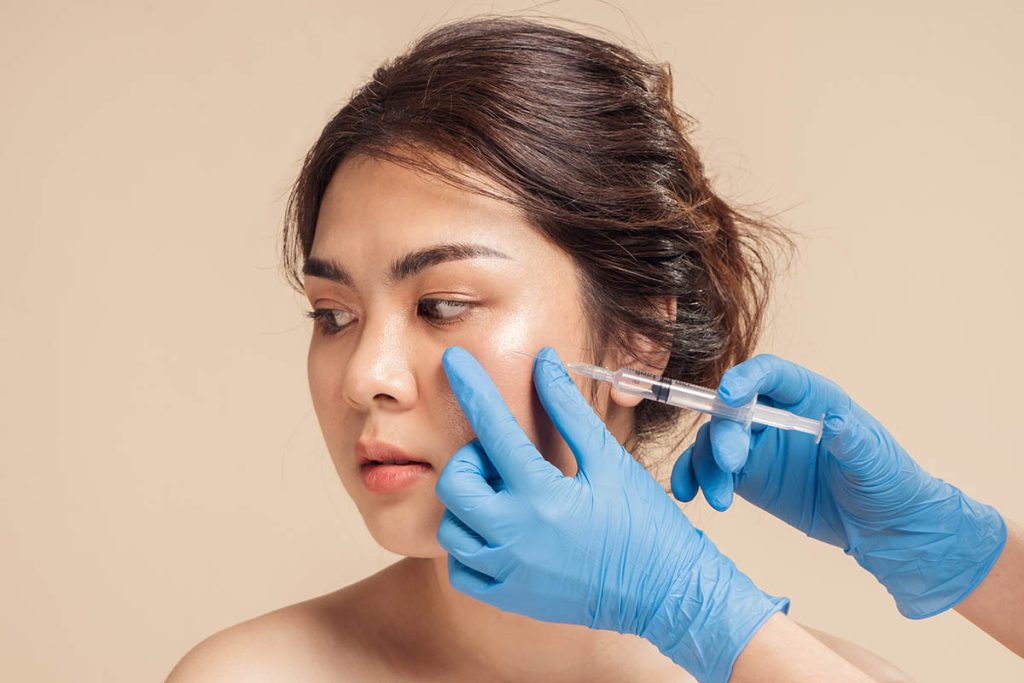What is Subcision?
Subcision is a procedure that is used to treat depressed scars. This outpatient procedure employs a hypodermic needle or cannula carefully inserted through a puncture in the skin surface.
The needle/cannula plays a crucial role in breaking fibrotic strands that tether the scar to the underlying tissue. By releasing these fibrotic strands and promoting new collagen deposition through the natural process of wound healing, subcision facilitates significant cosmetic improvement of the scar. Notably, subcision is well-tolerated and can be safely performed in an outpatient setting.
The technique's effectiveness lies in its ability to address the root cause of depressed scars, providing a viable solution for individuals seeking cosmetic enhancement.

How does Subcision work?
The subcision procedure involves several steps to address scar tissue. Firstly, the affected area is thoroughly cleansed to eliminate dirt and make-up. Surgical markers may be utilised to define scar margins, with overhead lighting adjustments for enhanced visibility of depressions.
Local anaesthetic may be administered, and a needle/cannula is then inserted at an acute angle beside the scar. The needle, positioned with the bevel upwards, is advanced through the dermis in a fan-like motion (fanning subcision). A distinctive snapping sound indicates the transection of fibrous bands in the deep dermal and subcutaneous plane.
Following this, the needle is rotated 90 degrees and moved again in a fan-like motion. Once completed, the needle is carefully removed, and manual pressure is applied to the wound for several minutes to prevent excessive bleeding and haematoma formation.
Benefits of Subcision
- Scar improvement: effectively improves the appearance of acne scars by breaking fibrotic strands that tether the scar to underlying tissue.
- Outpatient convenience: Subcision is a minor surgical procedure that can be safely performed in an outpatient setting, offering convenience for individuals seeking scar treatment.
- Well-tolerated: the procedure is generally well-tolerated by individuals.
- Minimal downtime: involves minimal downtime for many, allowing you to resume regular activities as soon as possible.
- Local anaesthetic: ensures a comfortable experience for individuals undergoing the procedure.
- Versatility: addresses various types of scars, providing a comprehensive solution for cosmetic concerns.
- Long-term results: continues to show results over time as scar tissue remodels, offering long-term cosmetic benefits.

What conditions can Subcision treat?
Subcision can be used to treat various types of scars and wrinkles:
- Rolling acne scars
- Boxcar acne scars
- Depressed bound down scars
What results can I expect from Subcision?
After the subcision procedure, you can expect noticeable improvements in the appearance of depressed cutaneous scars. While immediate results may be visible, the full extent of the treatment becomes more apparent over time.
The breaking of fibrotic strands during the procedure allows for scar tissue remodelling, leading to ongoing cosmetic benefits. Generally, you can experience a reduced depth of scars and improved skin texture. The procedure's effectiveness and minimal downtime make it a favourable option for those seeking long-term and natural-looking outcomes.
Individual responses may vary, and the degree of improvement is influenced by factors such as scar type and skin characteristics.
How many sessions of Subcision are needed?
The number of subcision sessions required depends on factors such as type, location, severity, and the intensity of the scar or wrinkle intervention. Generally, a few sessions are adequate for moderate scarring cases. It is recommended to schedule treatments at least one month apart to allow for optimal healing. The variations in collagen formation impact individual responses. Your clinician will tailor the approach based on your unique circumstances, ensuring a comprehensive and personalised treatment plan.
Interested in this treatment? Contact us today to find out if this treatment is suitable for you.
Frequently asked questions
How do I know if I need subcision?
Subcision suits you if you have persistent rolling or boxcar scars that do not improve with skin stretching or smiling. Even subtle changes may respond well, as there could be underlying tethering contributing to depressed scars. Subcision addresses existing tethering and stimulates new collagen formation, potentially improving the appearance of scars.
How long does subcision last?
Results from subcision are usually permanent as long as there is no re-anchoring or tethering of the scarafter the procedure.
How risky is subcision?
As with any surgical procedure, there are some risks to consider. While not common, the primary risk is bruising, with the potential for bleeding and haematoma formation. There is a very small risk of numbness but generally should it occur, temporary numbness lasts 2 to 4 months, while permanent numbness is rare. Uncommon risks include nerve damage, infections, collagen nodules, scarring (hypertrophic or keloid), colour changes, persistent swelling, lymphoedema, and sagging.
How long does it take for subcision results to show?
While you may notice immediate changes after subcision, the full results typically become visible within 1 to 4 months. Ongoing improvement may continue for up to a year as scar tissue undergoes further remodelling.

